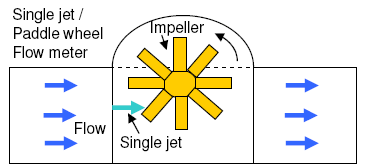Paddle wheel flow meters consist of three primary components: the paddle wheel sensor, the pipe fitting, and the display/controller.
The paddle wheel sensor consists of a freely rotating wheel or impeller with embedded magnets that is perpendicular to the flow and will rotate when inserted in the flowing medium.

As the magnets in the blades spin past the sensor, the paddle wheel meter generates a frequency and voltage signal which is proportional to the flow rate. The faster the flow the higher the frequency and the voltage output.
The paddle wheel meter is designed to be inserted into a pipe fitting, either ‘in-line’ or insertion style. These are available with a wide range of fittings styles, connection methods, and materials such as PVDF, polypropylene, and stainless steel. Similar to turbine meters, the paddle wheel meter requires a minimum run of straight pipe before and after the sensor.
Flow displays and controllers are used to receive the signal from the paddle wheel meter and convert it into actual flow rate or total flow values. The processed signal can be used to control the process, generate an alarm, send signals to external, etc.
Paddle wheel flow meters (also known as Pelton wheel sensors) offer a relatively low-cost, high-accuracy option for many flow system applications, typically with water or water-like fluids.
Typical applications for paddle wheel flow meters include the accurate measurement of preset fluid volumes in dispensing systems, control of chemical metering pump output, flow verification, irrigation systems, and alerting users to flow rate increases or decreases outside a programmed range.
If you liked this article, then please subscribe to our YouTube Channel for Instrumentation, Electrical, PLC, and SCADA video tutorials.
You can also follow us on Facebook and Twitter to receive daily updates.
Read Next:
Learn an example PLC program to control a pump based on level sensors using ladder…
In the PLC timer application for security camera recording, when motion is detected then camera…
In this example, we will learn batch mixing with PLC ladder logic program using timer…
This PLC example on manufacturing line assembly is an intermediate-level PLC program prepared for the…
In this article, you will learn the PLC programming example with pushbutton and motor control…
This article teaches how to convert Boolean logic to PLC programming ladder logic with the…
View Comments
Sir, what is the difference between paddle wheel flow meter and turbine flow meter ? thanks